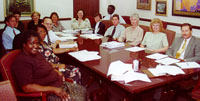‘Mail It’ to streamline campus mail system
by Dick PetersonPublic Relations
Time was the doctors around here would drop by a back door in the Library Administration Building once or twice a day to pick up their mail.
Those days yielded to a time when a mail room staff of seven people distributed fewer than 1,000 pieces of mail to fewer than 100 locations.
“It was a time when everybody knew everybody,” said MUSC Mail Services supervisor Eartha Bonneau.
 The
team is made up of the following members: Eartha Bonneau, Mail Service
Center; Kathleen Brower, Hospital Administration; Chris Darnell, UMA; Roy
Dingle, Business Services; Frances Glanville, Dept of Medicine; Dr. Richard
Hernadez, Dept of Health Professions; Rose Mary Hutchinson, Office of Development;
Ida Heyward, Institute of Psychiatry; Anna Skipper, Alumni Affairs; Wayne
Brannon, University Risk Management; Mitzi Fetner, Physical Asset Management;
Leslie Kendall, Strom Thurmond Building Manager; Christie King, Academic;
Steven Mengler, Transportation; Gwendolyn Green, Grants & Accounting;
and Jerry Redmond, Procurement.
The
team is made up of the following members: Eartha Bonneau, Mail Service
Center; Kathleen Brower, Hospital Administration; Chris Darnell, UMA; Roy
Dingle, Business Services; Frances Glanville, Dept of Medicine; Dr. Richard
Hernadez, Dept of Health Professions; Rose Mary Hutchinson, Office of Development;
Ida Heyward, Institute of Psychiatry; Anna Skipper, Alumni Affairs; Wayne
Brannon, University Risk Management; Mitzi Fetner, Physical Asset Management;
Leslie Kendall, Strom Thurmond Building Manager; Christie King, Academic;
Steven Mengler, Transportation; Gwendolyn Green, Grants & Accounting;
and Jerry Redmond, Procurement.
But times are changing. Everybody doesn’t know everybody any more. Seventeen Mail Services employees sort and distribute more than 18,000 pieces of mail with 400 addresses to 300 locations each day. And they truck most of it over to the main campus from Harborview Tower.
“It’s a problem that’s only getting worse,” said Business Services director John Runyon, who sees any viable solution centering on two needs: education and money. Education to teach people using Mail Services to properly address both campus and off-campus mail, and money for the facilities, employees, vehicles and automation needed to do the job well.
And that’s a job for “Mail It,” the mail services process improvement team formed to examine the present mail system, identify the problems, and present and evaluate solutions. They’ve already seen enough data and observed campus mail operations to know Mail Services employees are hobbled by a system that has failed to keep up with campus expansion.
“We thought that the mail room itself would be a total disaster, now we’re totally amazed they get it all out,” said Mail It member Frances Glanville, an administrative coordinator in the College of Medicine. She said that the most pressing problem to be solved was not in the mail room itself, but teaching those who use Mail Services how important it is to use proper addresses.
Runyon said that when mail circulated within the campus and coming onto the campus from the outside is addressed incompletely or incorrectly the entire operation slows down.
“It takes new mail room employees about six weeks to become efficient, because they have to learn names and departments to know how to sort properly,” Runyon said. “I’m afraid that if we had a couple people out sick, someone else on vacation and one or two retire, the whole operation would come to a standstill.”
“The success of Mail Services at MUSC depends on the memories of a few key people,” Glanville said.
The challenge the process improvement team faces is teaching campus mail customers that they need to participate in the delivery of their mail by properly addressing their mail, and that includes using the new five-digit box numbers.
“The only teeth I have in this system is to reject improper addresses,” Runyon said, adding that option is unacceptable given that he would have to reject up to 75 percent of them.
“We can’t operate like the U.S. Postal Service,” said team member Leslie Kendall.
Runyon said that the U.S. Postal Service delivers mail to addresses, not people. “If we could do the same, there would be a quantum leap in the quality of mail delivery at MUSC.
Another item on the process improvement team’s agenda is money. Mail Services is a cost recovery operation, Runyon said. That means Mail Services has to charge the people who use Mail Services to cover the cost of doing business, a funding method he has yet to find at any other university in the country. Part of the team’s mission statement includes finding an “equitable” way to charge departments for the services they use, for inter-department mail and mail to and from off-campus addresses.
Money-eating expenses the team sees looming on the horizon include:
- New centrally located facilities, one with a door big enough to accommodate standard mail carts.
- Employees to continually sort mail while others distribute it to addresses.
- Salary increases to retain experienced employees.
- Automatic sorting equipment to separate mail by box numbers.
- An additional truck to haul mail to on-campus and off-campus locations.
Internal:
Complete Name, Department Name, Mail Box Number
External incoming:
Name, Department Name, Street Location, PO Box Number, City, State,
Zip Code
External outgoing (return address):
Department Name, Street Address, PO Box Number, City, State, Zip Code